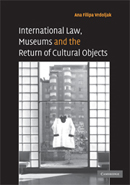review by Michael Pickering

I wish I had read this book before attending the February 2008 Paris Conference on repatriation held at Musee du quai Branly.[1] It would have armed me well to respond more strongly to those whose arguments consisted of recitation of the simplistic mantra that human remains stored in their collections were 'the heritage of all mankind' and should not be returned.[2] Vrdoljak demonstrates that for 200 years the full context of this statement was that the heritage value of such material was reliant upon appreciation that such remains and objects must be associated with the cultural group to whom they originally belonged. As Vrdoljak says, 'The underlying purpose that binds all rationales for the restitution of cultural objects in international law is ensuring the continuing contribution of a people and their culture — not cultural objects per se — to the cultural heritage of all humankind' (p. 300). I would get the book for this statement alone.
Vrdoljak has constructed a valuable book. Although a practitioner in repatriation, I was unaware of the history and breadth of previous debates associated with its practice at the international level. Written in a legal style, the book is sometimes a bit of a struggle for a non-legal reader — rich in case references (and acronyms). Nonetheless, it is still a fascinating and informative history and it should be a basic reference for all heritage professionals, not just those engaged in museums or repatriation and restitution. The roughly 200-year period that it encompasses, detailing the development of international law in the preservation of heritage, certainly mirrors the philosophies, principles and policies prevailing in the development of collecting institutions. However, it also reflects developments in the preservation of all tangible and intangible cultural heritage.
The book is divided into three major parts, each comprising three chapters. The parts take the reader on an exploration of 200 years in the development of international law in the area of restitution. Part One covers the post-Napoleonic period from 1815 to just after the First World War, a period that recognised the significance of the protection of heritage and restitution of appropriated objects to their states of origin. At the same time, however, growing colonial empires encouraged the accumulation and commoditisation of the heritage of minority cultures governed by the colonial regimes. Social evolutionary policies ensured that while peer states were recognised as having a right to restitution, smaller states and minority groups were still ignored, their cultural property increasingly appropriated in support of the nationalist ambitions of the governing state.
Part Two covers the period of the mid-twentieth century from the 1920s through to the 1960s. The horrors of the Second World War stimulated another major rethink on the rights of cultures to exist — the contribution 'of all peoples to the "cultural heritage of all (hu)mankind"' (p. 13). Following the dismantling of the colonial empires, and an end to their habits of appropriation (often by confiscation), came the growth in the acquisition of Indigenous and minority heritage objects as 'fine art', a phenomenon that also contributed to alienation of people and culture from their heritage objects (and the alienation of the objects from their cultural context) under the guise of free trade.
Part Three looks at the late twentieth century resurgence in the efforts of once colonised peoples and minority Indigenous groups to regain control of their cultural heritage through restitution. This has led museums in some parts of the world, including Australia, to redefine their roles and relationships with Indigenous peoples.
I do have some concerns with the book. Occasionally Vrdoljak's passions get the better of her and the whole museum industry receives a caning. This neglects the diversity in museum practice and the debates around restitution that are occurring at the institutional level. We are not all as culpable as Vrdoljak sometimes implies. I also disagree with her broad definition of the 'sacred', which she extends to mean any object with historical significance to a cultural group. It is an easy philosophy to apply that all objects are 'sacred' to their cultural group, but it is much harder to apply that definition in day-to-day management of heritage. Tighter definitions are required. Certainly many secular objects have grown in significance to their originating cultures over time and must be recognised as having a later significance beyond that held at the time of their original collection. Nonetheless, their secular origins and their historical growth in status must be acknowledged. Such items are certainly culturally significant.
It is also depressing to realise that for 200 years nations and states and cultural groups have been debating restitution, and that laws and protocols, while not perfect, have been introduced to manage international engagements. At the end of the day, when the squabbling starts, these conventions are not worth the paper they are printed on. From looting and destruction of heritage in the Napoleonic Wars to looting and destruction of heritage in the recent Middle East conflicts, at the level of international law nothing seems to have changed. Indeed, the real breakthroughs seem to be happening internally at the national and local levels, as for example in Australia, where repatriation is growing because of a philosophical commitment rather than a legislative one. Australian museums, and governments, return human remains and sacred objects because they want to, not because they have to.
These criticisms are minor. Vrdoljak's book will empower the reader sympathetic to repatriation and restitution. It deserves a place in every library associated with the museum sector.
Michael Pickering is director of the Aboriginal and Torres Strait Islander Program at the National Museum of Australia.
2 See my essay, 'Lost in Translation', in Borderlands, vol. 7, no. 2, www.borderlands.net.au/vol7no2_2008/pickering_lost.pdf.
